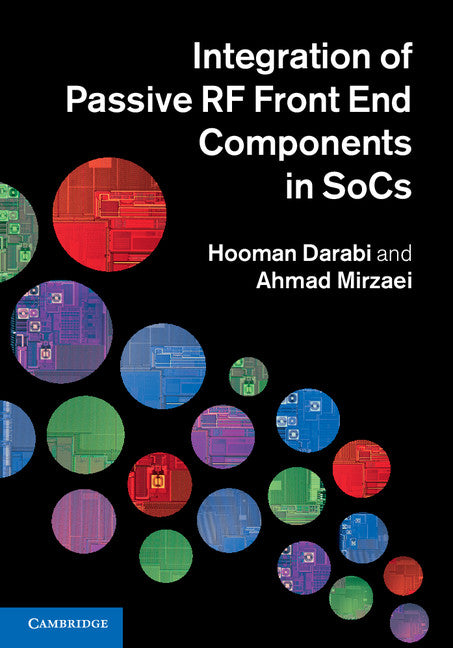Freshly Printed - allow 4 days lead
Couldn't load pickup availability
Integration of Passive RF Front End Components in SoCs
Describes and evaluates recent developments in the integration of passive components in wireless RF front ends, using real-world examples.
Hooman Darabi (Author), Ahmad Mirzaei (Author)
9780521111263, Cambridge University Press
Hardback, published 10 January 2013
200 pages, 110 b/w illus. 3 tables
25.3 x 17.7 x 1.2 cm, 0.56 kg
Examining the most important developments in highly integrated wireless RF front ends, this book describes and evaluates both active and passive solutions for on-chip high-Q filtering, and explores M-phase filters in depth. An accessible step-by-step approach is used to introduce everything an RF designer needs to know about these filters, including their various forms, principles of operation, and their performance against implementation-related imperfections. Real-world examples are described in depth, and detailed mathematical analyses demonstrate the practical quantification of pertinent circuit parameters.
1. Introduction to highly integrated and tunable RF receiver front ends: 1.1. Introduction
1.2. Front-end integration challenges and system requirements
1.3. 2G receiver SAW elimination
1.4. 3G receiver SAW elimination
1.5. Summary and conclusions
2. Active blocker-cancellation techniques in receivers: 2.1. Introduction
2.2. Concept of receiver translational loop
2.3. Nonideal effects
2.4. Circuit implementations
2.5. Measurement results
2.6. Feedback blocker-cancellation techniques
2.7. Summary and conclusions
3. Impedance transformation: Introduction to the simplest on-chip SAW filter
3.1. Introduction
3.2. Impedance transformation by a 50% passive mixer
3.3. Application as on-chip SAW filter
3.4. Impact of harmonics on the sharpness of the proposed filter
3.5. Differential implementation
3.6. Summary and conclusions
4. Four-phase high-Q bandpass filters: 4.1. Introduction
4.2. Impedance transformation by a four-phase filter
4.3. Differential implementation of four-phase high-Q bandpass filter
4.4. Application as an on-chip SAW filter
4.5. Impact of harmonics on the sharpness of the proposed filter
4.6. Four-phase high-Q bandpass filter with a complex baseband impedance
4.7. Four-phase high-Q bandpass filter with quadrature RF inputs
4.8. Harmonic upconversion and downconversion
4.9. A SAW-less receiver with on-chip four-phase high-Q bandpass filters
4.10. Summary and conclusions
5. M-phase high-Q bandpass filters: 5.1. Introduction
5.2. Impedance transformation by M-phase filters
5.3. Differential implementation of M-phase high-Q filter
5.4. Application as an on-chip SAW filter
5.5. Impact of harmonics on the sharpness of the M-phase bandpass filter
5.6. M-phase high-Q filter with complex baseband impedances
5.7. M-phase high-Q bandpass filter with quadrature RF inputs
5.8. M-phase high-Q bandpass filter with N-phase complex bandpass filters
5.9. Harmonic upconversion
5.10. Summary and conclusions
6. Design of a superheterodyne receiver using M-phase filters: 6.1. Introduction
6.2. Proposed superheterodyne receiver architecture
6.3. Design and implementation of the receiver chain
6.4. Measurement results
6.5. Summary and conclusions
7. Impact of imperfections on the performance of M-phase filters: 7.1. Introduction
7.2. Mathematical background
7.3. LO phase noise
7.4. Second-order nonlinearity in the switches of the bandpass filter
7.5. Quadrature error in the original 50% duty-cycle clock phases
7.6. Harmonic downconversion
7.7. Thermal noise of switches
7.8. Parasitic capacitors of switches
7.9. Switch charge injection
7.10. Mismatches
7.11. Summary and conclusions
8. M-phase filtering and duality: 8.1. Introduction
8.2. Dual of an electrical circuit
8.3. Dual of M-phase filter
8.4. Dual of M-phase high-Q filter with complex baseband impedances
8.5. Summary and conclusions
Appendix
References
Index.
Subject Areas: Communications engineering / telecommunications [TJK], Microwave technology [TJFN], Circuits & components [TJFC], Electronics engineering [TJF], Electronics & communications engineering [TJ], Electrical engineering [THR]


